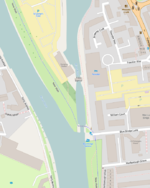Raindale Mill
Mill museums in EnglandMuseums in YorkUse British English from August 2015Watermills in North YorkshireYork Museums Trust

Raindale Mill is a reconstructed early 19th-century flour mill which was moved from Raindale Valley on the North York Moors to the grounds of York Castle Museum in the 1960s.
Excerpt from the Wikipedia article Raindale Mill (License: CC BY-SA 3.0, Authors, Images).Raindale Mill
Tower Street, York Fishergate
Geographical coordinates (GPS) Address Phone number Website Nearby Places Show on map
Geographical coordinates (GPS)
| Latitude | Longitude |
|---|---|
| N 53.9548 ° | E -1.0781 ° |
Address
York Castle Museum
Tower Street
YO1 9RY York, Fishergate
England, United Kingdom
Open on Google Maps










